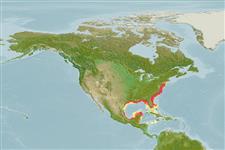>
Clupeiformes (Herrings) >
Engraulidae (Anchovies) > Engraulinae
Etymology: Anchoa: Italian ancioa = anchovy (Ref. 45335).
Eponymy: Dr Samuel Latham Mitchill (1764–1831) was an American physician, naturalist and politician. [...] (Ref. 128868), visit book page.
More on author: Valenciennes.
Environment: milieu / climate zone / depth range / distribution range
Ökologie
seewasser; süßwasser; brackwasser; amphidrom (Ref. 51243); tiefenbereich 1 - 70 m (Ref. 93252), usually 1 - 36 m (Ref. 189). Subtropical; 42°N - 16°N, 99°W - 72°W (Ref. 189)
Western Atlantic: Casco Bay, Maine south to Florida Keys and westward around the Gulf of Mexico south to Yucatán; not in the West Indies.
Length at first maturity / Size / Gewicht / Alter
Maturity: Lm 4.3, range 4 - 4.5 cm
Max length : 10.0 cm SL Männchen/unbestimmt; (Ref. 189); common length : 6.0 cm TL Männchen/unbestimmt; (Ref. 12193)
Rückenflossenstacheln (insgesamt) : 0; Rückenflossenweichstrahlen (insgesamt) : 0; Afterflossenstacheln: 0; Afterflossenweichstrahlen: 23 - 31. Body variable, more slender in northern populations. Snout fairly blunt, a little over 1/2 eye diameter; maxilla long, tip pointed, reaching beyond hind border of pre-operculum, almost to gill opening; panamensis-type gill cover canals. Anal fin rays rarely 28, its origin below unbranched dorsal fin rays. Anus nearer to pelvic fin tips than to anal fin origin.
More commonly found in shallow tidal areas with muddy bottoms and brackish waters, tolerating a wide range of salinities (virtually fresh to fully saline or hypersaline). Found only in spring and summer in the tidal portion of the Ochlockonee River, Florida. Feed mostly on Mysis and copepods, also small fishes, gastropods and isopods. Breed off North Carolina from late April to mid-July, perhaps through to August. Used to some extent to make anchovy paste (Ref. 189).
Spawn in school (Ref. 205).
Whitehead, P.J.P., G.J. Nelson and T. Wongratana, 1988. FAO Species Catalogue. Vol. 7. Clupeoid fishes of the world (Suborder Clupeoidei). An annotated and illustrated catalogue of the herrings, sardines, pilchards, sprats, shads, anchovies and wolf-herrings. FAO Fish. Synop. 125(7/2):305-579. Rome: FAO. (Ref. 189)
IUCN Rote Liste Status (Ref. 130435: Version 2024-1)
Bedrohung für Menschen
Harmless
Nutzung durch Menschen
Fischereien: weniger kommerziell; Köder: usually
Tools
Zusatzinformationen
Download XML
Internet Quellen
Estimates based on models
Preferred temperature (Ref.
123201): 13.2 - 26.9, mean 24 °C (based on 432 cells).
Phylogenetic diversity index (Ref.
82804): PD
50 = 0.5000 [Uniqueness, from 0.5 = low to 2.0 = high].
Bayesian length-weight: a=0.00589 (0.00475 - 0.00730), b=3.16 (3.12 - 3.20), in cm total length, based on LWR estimates for this species (Ref.
93245).
Trophic level (Ref.
69278): 3.3 ±0.33 se; based on food items.
Widerstandsfähigkeit (Ref.
120179): hoch, Verdopplung der Population dauert weniger als 15 Monate. (K>0.30; tmax=3).
Fishing Vulnerability (Ref.
59153): Low to moderate vulnerability (31 of 100).
Climate Vulnerability (Ref.
125649): Moderate to high vulnerability (50 of 100).
Nutrients (Ref.
124155): Calcium = 204 [126, 469] mg/100g; Iron = 1.83 [1.02, 3.40] mg/100g; Protein = 17.8 [15.4, 20.5] %; Omega3 = 0.543 [0.295, 1.019] g/100g; Selenium = 15.6 [7.4, 36.6] μg/100g; VitaminA = 28.9 [9.4, 78.9] μg/100g; Zinc = 1.42 [0.97, 2.19] mg/100g (wet weight);
